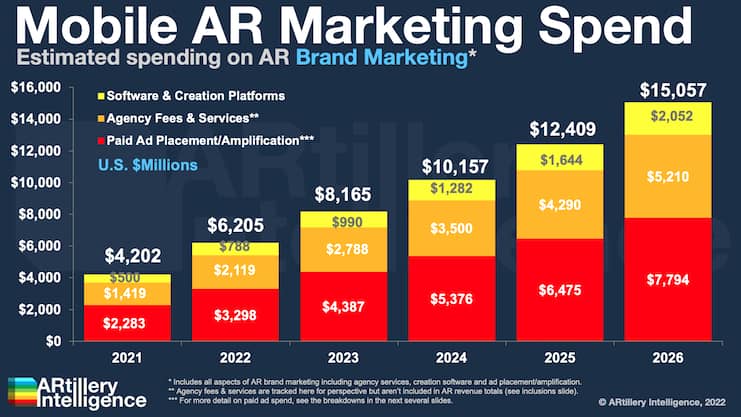
Like many analyst firms, market sizing is one of the ongoing practices of AR Insider’s research arm ARtillery Intelligence. A few times per year, it goes into isolation and buries itself deep in financial modeling. The latest such exercise zeroes in on mobile AR revenues.
This takes the insights and observations accumulated throughout the year and synthesizes them into hard numbers for spatial computing (see methodology and inclusions/exclusions). It’s all about an extensive forecast model coupled with rigor in assembling reliable inputs.
So what did the latest forecast uncover? At a high level, global mobile AR revenue is projected to grow from $12.45 billion in 2021 to $36.26 billion in 2026, a 23.8 percent CAGR. This sum consists of mobile AR consumer and enterprise spending and their revenue subsegments.
Drilling down, our latest Behind the Numbers installment looks specifically at mobile AR marketing and advertising. How much is being spent by consumer brands to promote their products through immersive AR experiences? This is one of mobile AR’s top revenue categories.
Ample Headroom
Starting at the top, global mobile AR advertising is projected to grow from $4.2 billion in 2021 to $15.1 billion in 2026. This includes a few things: software used for AR campaign creation (e.g., 8th Wall, Zappar), agency fees for campaign creation, and paid ad placement.
Drilling down on the latter, this is all about paid media portions of a given AR campaign. It includes paid distribution in places like Snapchat and Facebook. That’s opposed to self-distributed AR marketing, such as brands that launch AR marketing in their own apps or websites.
Paid placement also leads the above spending categories as brands increasingly see the benefit of sponsored lenses such as product try-ons. It not only lets them demonstrate products with greater dimension, but it shows a strong business case through high-performing ads.
This all leads to $7.8 billion in ad spend by 2026, a 27.8 percent compound annual growth rate. That rate is driven by the figure’s relatively base today. Speaking of relatively low, there’s ample headroom given that $7.8 billion is about 1 percent of the $738 billion total global ad spend.

Captions for the Real World
In terms of formats, AR lenses lead today, such as selfie fodder from Snap and Meta – including the increasingly AR-infused Instagram. Among social AR players today, Snap has the revenue lead due to organizational focus, greater levels of lens engagement and monetization per user.
Meanwhile, TikTok is the wild card with massive scale and a new AR platform. Visual search — pointing your phone at products to identify them — will gain ground in later years. It will be driven by a practical and frequent use case that’s naturally monetizable (like web search).
In fact, visual search could be an AR killer app as capability and consumer acclimation develop. Also what we call “captions for the real world,” it has true utility, which tends to sustain as technologies mature. Meanwhile, it’s under-monetized today as Google and others test the waters.
Lastly, what about macroeconomic factors? Though advertising is a famously recession-prone category, AR ads could ultimately benefit as downturns cause advertisers to redeploy budget to emerging and performant formats. We saw the same thing with search and social.
We’ll pause there and circle back in the next Behind the Numbers article to zero in on another AR revenue category…

